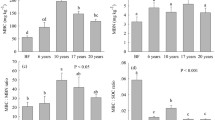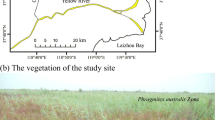Abstract
In the southernmost part of coast of China, two height forms of Spartina alterniflora, tall and short, have invaded Leizhou Peninsula within the last decade. However, the effect of different height forms of Spartina alterniflora on plant–microbe interaction has not been clarified. Here, the community structures of rhizosphere bacteria and the abundance of N- and S-cycling functional genes associated with selected S. alterniflora were investigated in the field and a common garden. The community structure of tall-form S. alterniflora was distinct from short-form S. alterniflora at OTU level in the field, even after transplantation into a common garden. The abundance of bacterial amoA, nirS, and nosZ in tall S. alterniflora was significantly greater than those in short S. alterniflora in the field; however, this difference disappeared in a 1-year common garden experiment. These results suggested that compared with the tall-form S. alterniflora, the rhizosphere of short-form S. alterniflora harbored fewer nitrification–denitrification related microorganisms, which might benefit from conserving N in an N limited habitat. Together, our results suggested that tall- and short-form S. alterniflora can host their specific rhizosphere microbial communities and had different strategies of N usage via selecting the composition of rhizosphere bacterial assemblages, which in turn might determine the growth and invasiveness of S. alterniflora in its introduced range.







Similar content being viewed by others
References
Mendes R, Garbeva P, Raaijmakers JM (2013) The rhizosphere microbiome: significance of plant beneficial, plant pathogenic, and human pathogenic microorganisms. FEMS Microbiol Rev. 37:634–663. https://doi.org/10.1111/1574-6976.12028
Berendsen RL, Pieterse CM, Bakker PA (2012) The rhizosphere microbiome and plant health. Trends Plant Sci. 17:478–486. https://doi.org/10.1016/j.tplants.2012.04.001
Haichar FE, Marol C, Berge O, Rangel-Castro JI, Prosser JI, Balesdent J, Heulin T, Achouak W (2008) Plant host habitat and root exudates shape soil bacterial community structure. ISME J 2:1221–1230. https://doi.org/10.1038/ismej.2008.80
Bais HP, Walker TS, Schweizer HP, Vivanco JA (2002) Root specific elicitation and antimicrobial activity of rosmarinic acid in hairy root cultures of Ocimum basilicum. Plant Physiol Biochem 40:983–995. https://doi.org/10.1016/s0981-9428(02)01460-2
Zhang S, Zhu W, Wang B, Tang J, Chen X (2011) Secondary metabolites from the invasive Solidago canadensis L. accumulation in soil and contribution to inhibition of soil pathogen Pythium ultimum. Appl. Soil Ecol. 48:280–286. https://doi.org/10.1016/j.apsoil.2011.04.011
Huang J, Xu X, Wang M, Nie M, Qiu S, Wang Q, Quan Z, Xiao M, Li B (2016) Responses of soil nitrogen fixation to Spartina alterniflora invasion and nitrogen addition in a Chinese salt marsh. Sci. Rep. 6. https://doi.org/10.1038/srep20384
Jia D, Qi F, Xu X, Feng J, Wu H, Guo J, Lu W, Peng R, Zhu X, Luo Y (2016) Co-regulations of Spartina alterniflora invasion and exogenous nitrogen loading on soil N2O efflux in subtropical mangrove mesocosms. PLoS One 11:e0146199. https://doi.org/10.1371/journal.pone.0146199
An S, Gu B, Zhou C, Wang Z, Deng Z, Zhi Y, Li H, Chen L, Yu D, Liu Y (2007) Spartina invasion in China: implications for invasive species management and future research. Weed Res. 47:183–191. https://doi.org/10.1111/j.1365-3180.2007.00559.x
Liu W, Maung-Douglass K, Strong DR, Pennings SC, Zhang Y (2016) Geographical variation in vegetative growth and sexual reproduction of the invasive Spartina alterniflora in China. J. Ecol. 104:173–181. https://doi.org/10.1111/1365-2745.12487
Strong DR, Ayres DR (2013) Ecological and evolutionary misadventures of Spartina. Annu Rev Ecol Evol Syst 44:389–410. https://doi.org/10.1146/annurev-ecolsys-110512-135803
Wan S, Qin P, Liu J, Zhou H (2009) The positive and negative effects of exotic Spartina alterniflora in China. Ecol. Eng. 35:444–452. https://doi.org/10.1016/j.ecoleng.2008.05.020
Zhang Y, Huang G, Wang W, Chen L, Lin G (2012) Interactions between mangroves and exotic Spartina in an anthropogenically disturbed estuary in southern China. Ecology 93:588–597. https://doi.org/10.1890/11-1302.1
Gallagher JL, Somers GF, Grant DM, Seliskar DM (1988) Persistent differences in two forms of Spartina alterniflora: a common garden experiment. Ecology 69:1005–1008. https://doi.org/10.2307/1941255
Mendelssohn IA, McKee KL (1988) Spartina alterniflora die-back in Louisiana: time-course investigation of soil waterlogging effects. J. Ecol. 76:509–521. https://doi.org/10.2307/2260609
Degnan PH, Ochman H (2012) Illumina-based analysis of microbial community diversity. ISME J 6:183–194. https://doi.org/10.1038/ismej.2011.74
Hu A, Yang X, Chen N, Hou L, Ma Y, Yu C-P (2014) Response of bacterial communities to environmental changes in a mesoscale subtropical watershed, Southeast China. Sci Total Environ 472:746–756. https://doi.org/10.1016/j.scitotenv.2013.11.097
Gremion F, Chatzinotas A, Harms H (2003) Comparative 16S rDNA and 16S rRNA sequence analysis indicates that Actinobacteria might be a dominant part of the metabolically active bacteria in heavy metal-contaminated bulk and rhizosphere soil. Environ Microbiol 5:896–907. https://doi.org/10.1046/j.1462-2920.2003.00484.x
Dar SA, Yao L, van Dongen U, Kuenen JG, Muyzer G (2007) Analysis of diversity and activity of sulfate-reducing bacterial communities in sulfidogenic bioreactors using 16S rRNA and dsrB genes as molecular markers. Appl Environ Microbiol 73:594–604. https://doi.org/10.1128/AEM.01875-06
Francis CA, Roberts KJ, Beman JM, Santoro AE, Oakley BB (2005) Ubiquity and diversity of ammonia-oxidizing archaea in water columns and sediments of the ocean. Proc Natl Acad Sci U S A 102:14683–14688. https://doi.org/10.1073/pnas.0506625102
Henry S, Bru D, Stres B, Hallet S, Philippot L (2006) Quantitative detection of the nosZ gene, encoding nitrous oxide reductase, and comparison of the abundances of 16S rRNA, narG, nirK, and nosZ genes in soils. Appl Environ Microbiol 72:5181–5189. https://doi.org/10.1128/aem.00231-06
Jemaneh Zeleke QS, Wang J-G, Huang M-Y, Xia F, Wu J-H, Quan Z-X (2013) Effects of Spartina alterniflora invasion on the communities of methanogens and sulfate-reducing bacteria in estuarine marsh sediments. Front. Microbiol. 4. doi: https://doi.org/10.3389/fmicb.00243
Magalhães CM, Machado A, Matos P, Bordalo AA (2011) Impact of copper on the diversity, abundance and transcription of nitrite and nitrous oxide reductase genes in an urban European estuary. FEMS Microbiol Ecol 77:274–284. https://doi.org/10.1111/j.1574-6941.2011.01107.x
Muyzer G, De Waal EC, Uitterlinden AG (1993) Profiling of complex microbial populations by denaturing gradient gel electrophoresis analysis of polymerase chain reaction-amplified genes coding for 16S rRNA. Appl Environ Microbiol 59:695–700
Poly F, Monrozier LJ, Bally R (2001) Improvement in the RFLP procedure for studying the diversity of nifH genes in communities of nitrogen fixers in soil. Res. Microbiol. 152:95–103. https://doi.org/10.1016/S0923-2508(00)01172-4
Rotthauwe J-H, Witzel K-P, Liesack W (1997) The ammonia monooxygenase structural gene amoA as a functional marker: molecular fine-scale analysis of natural ammonia-oxidizing populations. Appl Environ Microbiol 63:4704–4712
Edgar RC, Haas BJ, Clemente JC, Quince C, Knight R (2011) UCHIME improves sensitivity and speed of chimera detection. Bioinformatics 27:2194–2200. https://doi.org/10.1093/bioinformatics/btr381
Parks DH, Tyson GW, Hugenholtz P, Beiko RG (2014) STAMP: statistical analysis of taxonomic and functional profiles. Bioinformatics 30:3123–3124. https://doi.org/10.1093/bioinformatics/btu494
Uroz S, Buée M, Murat C, Frey-Klett P, Martin F (2010) Pyrosequencing reveals a contrasted bacterial diversity between oak rhizosphere and surrounding soil. Environ Microbiol Rep 2:281–288. https://doi.org/10.1111/j.1758-2229.2009.00117.x
Weinert N, Piceno Y, Ding G-C, Meincke R, Heuer H, Berg G, Schloter M, Andersen G, Smalla K (2011) PhyloChip hybridization uncovered an enormous bacterial diversity in the rhizosphere of different potato cultivars: many common and few cultivar-dependent taxa. FEMS Microbiol. Ecol. 75:497–506. https://doi.org/10.1111/j.1574-6941.2010.01025.x
Xia F, Zeleke J, Sheng Q, Wu J-H, Quan Z-X (2015) Communities of ammonia oxidizers at different stages of Spartina alterniflora invasion in salt marshes of Yangtze River estuary. J. Microbiol. 53:311–320. https://doi.org/10.1007/s12275-015-4660-0
Zheng Y, Bu N-S, Long X-E, Sun J, He C-Q, Liu X-Y, Cui J, Liu D-X, Chen X-P (2017) Sulfate reducer and sulfur oxidizer respond differentially to the invasion of Spartina alterniflora in estuarine salt marsh of China. Ecol. Eng. 99:182–190. https://doi.org/10.1016/j.ecoleng.2016.11.031
DeAngelis KM, Ji P, Firestone MK, Lindow SE (2005) Two novel bacterial biosensors for detection of nitrate availability in the rhizosphere. Appl Environ Microbiol 71:8537–8547. https://doi.org/10.1128/AEM.71.12.8537-8547.2005
Koch B, Worm J, Jensen LE, Højberg O, Nybroe O (2001) Carbon limitation induces ςS-dependent gene expression in pseudomonas fluorescens in soil. Appl Environ Microbiol 67:3363–3370. https://doi.org/10.1128/AEM.67.8.3363-3370.2001
Yang L, Chang H-T, Huang M-NL (2001) Nutrient removal in gravel-and soil-based wetland microcosms with and without vegetation. Ecol Eng 18:91–105. https://doi.org/10.1016/S0925-8574(01)00068-4
Stottmeister U, Wießner A, Kuschk P, Kappelmeyer U, Kästner M, Bederski O, Müller R, Moormann H (2003) Effects of plants and microorganisms in constructed wetlands for wastewater treatment. Biotechnol. Adv. 22:93–117. https://doi.org/10.1016/j.biotechadv.2003.08.010
Muyzer G, Stams AJ (2008) The ecology and biotechnology of sulphate-reducing bacteria. Nat Rev Microbiol 6:441–454. https://doi.org/10.1038/nrmicro1892
Klein M, Friedrich M, Roger AJ, Hugenholtz P, Fishbain S, Abicht H, Blackall LL, Stahl DA, Wagner M (2001) Multiple lateral transfers of dissimilatory sulfite reductase genes between major lineages of sulfate-reducing prokaryotes. J. Bacteriol. 183:6028–6035. https://doi.org/10.1128/JB.183.20.6028-6035.2001
Klepac-Ceraj V, Bahr M, Crump BC, Teske AP, Hobbie JE, Polz MF (2004) High overall diversity and dominance of microdiverse relationships in salt marsh sulphate-reducing bacteria. Environ Microbiol 6:686–698. https://doi.org/10.1111/j.1462-2920.2004.00600.x
Acknowledgments
We thank Professor John Hodgkiss of the City University of Hong Kong for his assistance with the English language.
Funding
This research was supported by the Fundamental Research Funds for the Central Universities (Grant No. 20720150097).
Author information
Authors and Affiliations
Corresponding authors
Ethics declarations
Conflict of Interest
The authors declare that they have no conflict of interest.
Ethical Approval
This article does not contain any studies with human participants or animals performed by any of the authors.
Electronic Supplementary Material
Table S1
(DOCX 18 kb)
Rights and permissions
About this article
Cite this article
Lin, L., Liu, W., Zhang, M. et al. Different Height Forms of Spartina alterniflora Might Select Their Own Rhizospheric Bacterial Communities in Southern Coast of China. Microb Ecol 77, 124–135 (2019). https://doi.org/10.1007/s00248-018-1208-y
Received:
Accepted:
Published:
Issue Date:
DOI: https://doi.org/10.1007/s00248-018-1208-y




